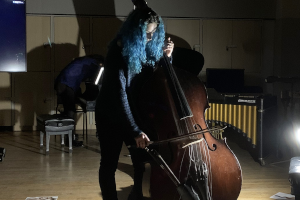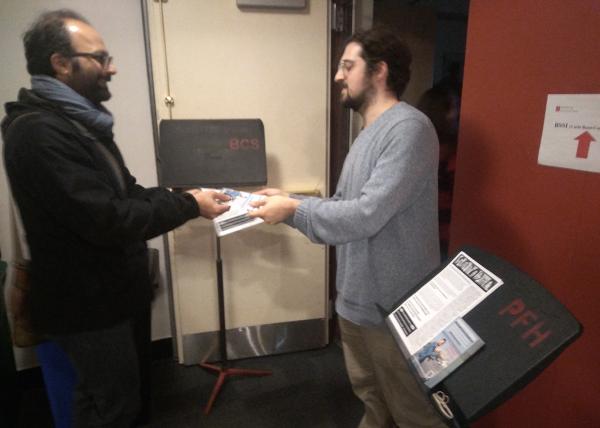The lights were dimmed. A circle of musicians was seated around a video screen, with audience members around them. Then the double bass player began, straddling her instrument as it lay flat on the floor. She played with two bows, coaxing out “murky” sounds as she put it, sounds one of the composers later said he had no idea the instrument could produce. The darkness underscored the seriousness, intensity, and drama of the music and the moment—here in the room, and far away in Iran.
It was her first time playing this way. “I was asked to be in a precarious, uncomfortable position, which was intentional, purposeful, and symbolic,” she said, “And I was happy to do it for a purpose.”

Student at Manhattan School of Music plays opening section in the collaborative tribute to struggle of Iranian people, “For the People Of...”
“For the People Of,” a concert in support of Iranian prisoners was held at the Manhattan School of Music on Friday, December 2. This “collaboration between Iranian composers both in and outside the country” was “dedicated to the people imprisoned in Iran, many of whom are artists and musicians, for protesting their government,” the musician organizers wrote.
Over a riveting two plus hours, the humanity and courageous struggle of the Iranian people and the brutality of Iran’s ruling regime was conveyed—better, driven home—through intense, cacophonous, haunting music, spoken word, short presentations, and video in English and Farsi. The 25 or so audience members, overwhelmingly students, had been met at the door by one of the musicians handing out the IEC’s Emergency Appeal, and its “Freedom for Toomaj!” palmcard. Around the room, sheets of paper with color drawings of women’s hair had been taped to the floor.

Student distributes the IEC call for political prisoners in Iran to concert goers. Photo: Courtesy of "For the People Of" concert
Four compositions—Zakhmeh (Wounds), The Time Has Come, Crackdown, and Our Song—each by a different composer, were the heart and driving force of the evening. Each was “influenced by improvisation, as a result of which the musicians express the experience of liberation in their performance,” the musician-organizers wrote.
The performers—men and women, from different parts of the U.S. and the world—included piano, double bass, steel string guitar, electric guitar, flute, alto sax, bass clarinet, percussion, violin, and voice. Other music students contributed set up, lighting, sound, and other elements.
Zakhmeh began quietly, with eerie, ethereal music from the double bass, with tension building as other instruments joined in. The Time Has Come had the feel of tensions building, “spreading the word and collecting forces,” as a friend put it, as music echoed and two singers circled the room whispering “Mahsa,” “Continue,” “Don’t be afraid.”
Crackdown opened with a furious, pounding piano and percussion blast—the pianist standing up and attacking its strings by hand. The intensity built as the other instruments mounted a gathering assault—“unmistakably street fighting music” a friend commented. One of the musicians explained afterward, that the “piano represents the tyrannical forces and everyone else represents protesters and in the end we all came together” to defeat the repressive forces. Our Song felt more accessible, hopeful, forward looking.
The audience was rapt throughout.
Afterward, the Iranian composer who opened the evening with a poem in Farsi and English about the bird, iconic in Iran, that symbolizes hope arising from all the pain and suffering people feel. “Every piece had this idea—out of the suffering this spirit rises, in the end this common voice comes from the bird. You go on a journey, an intense journey. The whole evening was very emotional—I felt like I was going to cry.”
The violin player showed me her “sheet music,” which was comprised of lines designating the rising and falling intensity for each instrument, i.e., the basic storyline. Within that framework, she explained, each musician contributed their individual interpretation. It was like a “call and response to other musicians in the room,” which demands very careful, attentive listening to the other musicians.
“In this performance we managed to encompass the full range of human emotions, from very intense to very reflective.” In Crackdown, “we were being individual protesters. I was trying to be a violently outspoken protester—you all make your choice. What character is missing in this mix and what should I add to it. It’s very emotional to put yourself in this role. It’s the closest thing I could do to acting. It was a very emotional experience to play the piece.”
She added, “For me, the immediacy of music and how it touches you is very different than reading something. Music has an immediate emotional impact. I was trying not to cry. The whole experience was very compelling. It’s hard to know how to help in a meaningful way, so I was happy I could be part of spreading news about it [the struggle in Iran], touching other people, and sharing stories. It means a lot to me.”
“We Plan to Do It Again, and Make It Bigger”
“This concert seeks to not only challenge the oppressive forces in power in Iran, but to also envision a better structure and society that values the emancipation and well-being of all people.”
—Concert organizers
“What is happening in Iran is that the people have had enough,” the main musician-organizer of the concert said. “There’s a structure in place over there and the people are simply saying they don’t accept it. What I’m trying to do with my music is basically questioning the structures and challenge the structures that are imposed on us. Those on top of the structure want us to conform, but we don’t have to; we don’t have to accept what we have; we can strive for something else. That’s what the people of Iran are doing and its very inspiring to me. And I think it translates into the arts. That’s what we need art for—to challenge ourselves and to challenge the structures we live under.”
“We plan on doing it again in other venues and making it bigger, making it a series. ‘For the People Of’ originally started with the Iranian people in mind. But I’m trying to see a bigger picture. What’s going on in Iran could potentially cause similar uprisings to happen in other countries. I think the whole world is watching. And it’s a really crucial moment over there. So ‘For the People Of’ is an invitation to the audience to fill in that blank. It’s for which people? The people of the world? The people of Iran? The people of the United States? The people of Haiti? Which people? It’s for all the people!”